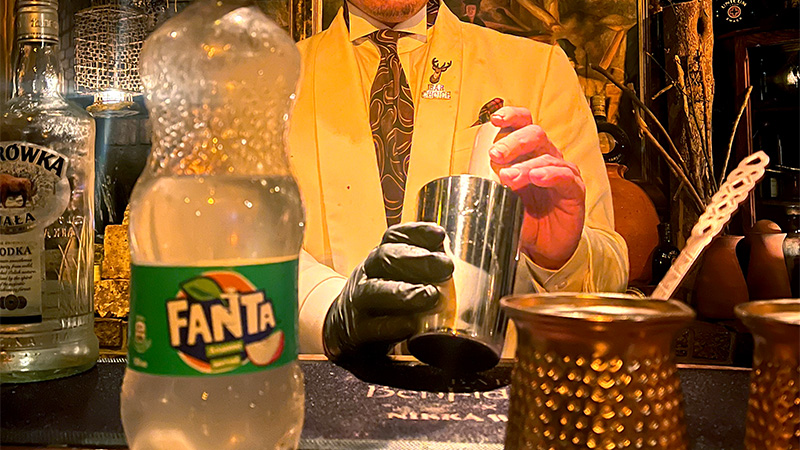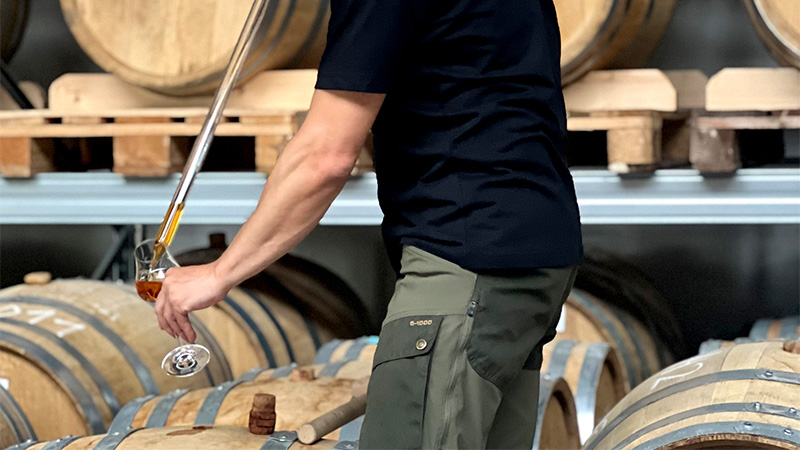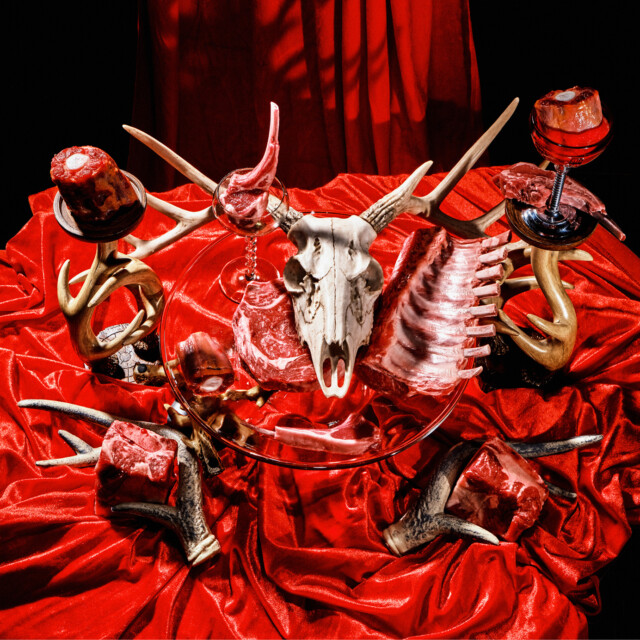The Bullshot cocktail — a mid-century, Midwestern beef bouillon-and-vodka boozer — was a staple at Detroit’s Caucus Club, the popular Detroit steakhouse where it was invented in the 1950s by a local ad exec eager to push Campbell’s soup on the liquid lunch crowd. Now, three quarters of a century later, the appetite for meat-forward boozing has resurfaced with bloodlust, and bars and distilleries around the world are responding with modern technique and marketing prowess to match.
Taking Stock
Today, the Bullshot is the signature drink of the backroom Orchid Bar at The Okura Tokyo. There, it is an appetite-whetting aperitif made with fresh beef consommé for what became an unexpected exploration of meaty drinking across Japan, a country that’s become an incubator for protein-forward mixology.
Across the street from the Okura, acclaimed cacao bar Memento Mori lies buried within the unremarkable mall of a labyrinthine Toranomon Hills office park. Buried in its menu behind husk and nib fizzes and sours, the back-page Bologna Negroni features cacao-infused wine and Campari which wrestle with the weight of Bolognese sauce-infused vodka — all of it swirling around an ice block piled high with Parmigiano Reggiano. It might have been the funkiest concoction one could sip in the city, lest you dare unflappable Bar Ben Fiddich owner Haruyasu Kayamato let loose a Ramos Vodka Fizz with the fermented horse milk vodka he smuggled back from Mongolia in a repurposed Fanta bottle. When he’s game, the end result is a gamy kefir.

That said, such wild swings focus too much on spicing up established cocktail recipes and don’t do enough to showcase the natural essence of the proteins in play, according to Tomoiki Sekine, the proprietor of Kyoto’s Nokishita 711. Sekine is the true heir to the legacy of the Bullshot; he creates his drinks through a method he calls “extract-o-logy” which involves brewing and fermenting whole animal stocks for weeks until he achieves a “clear umami taste.”
“Sometimes fermentation can go too far, especially in Japan, because making alcohol at a bar is illegal, so my fermentation stops at the point of the sourness,” Sekine explains.
“The appetite for meat-forward boozing has resurfaced with bloodlust, and bars and distilleries around the world are responding with modern technique and marketing prowess to match.”
Sekine devises seasonal, five-course cocktail omakase menus he calls “liquid cuisine” to four guests per seating. Behind an inscrutable, heavily cluttered kitchen, the bar chef will approach a communal table with courses described by their ingredients, like the “Deer, Strawberry, Coffee, Beets, Burdock Peppers, Rice Shochu, Vodka” paired with a deer meat taco dressed in coffee miso and yuzu. He envisions the drink before the food pairing, which he makes from the leftover ingredients — not out of any commitment to sustainability, but to reinforce the flavor of his stocks, which have included raccoon, bear, boar, and chicken.
“The deer stock is made with meat and liver, and comes from a hunter friend who sends me wild animals during the winter season,” Sekine explains. “There are too many wild deer in Japan now, so hunting them is popular, but eating the meat is not so common and the meat goes to waste.”
Bones and Bitters
Improbably, deer are not going to waste in the spirits world. Lasse Öznek, master distiller at Denmark’s Copenhagen Distillery, and his research and development chief Sune Urth first experimented with roe deer in 2020 when they introduced their Schweiss Jagt Bitter: a spirited coping mechanism for weathering winters in the woods flavored not just with deer blood and bones, but also forest floor and sea botanicals one might find on a hunt.
Urth explaines the unconventional process: “When we were first approached with the proposal to make the bitter, our first thought was to shoot something ourselves, but as none of us had a license, we allied ourselves with a guy who had. We had him shoot a deer in the woods, and drain the blood directly into a case of bottles that we gave him, half-full with pure alcohol.”
Öznek and Urth distilled the blood extraction as a base for the final product. For their second go, they visited a deer farmer who provided them with pasteurized blood and bones, which passed muster with Denmark’s food safety administration.

“It’s fairly common to use animal products in mezcal production, but EU legislation is very strict when it comes to distilleries,” Öznek says. “It’s much easier to muck about in a bar. There will always be a playground for these limited edition projects, but cocktail bars make better storytellers.” Still, they put the seasoned Hungarian oak cask to work once the bitter was bottled, creating a rich single malt whiskey rich in umami.
Likeminded Tamworth Distillery in New Hampshire’s White Mountains has achieved similar success. The operation is known for its novelties like Eau de Musc and Crab Trapper Whiskey, the latter of which is made from local green crabs and a bourbon base. The distillery recently gave red deer a spin by blending chopped, fermented, and slow-smoked venison with a 3-year old white wheat whiskey in their Rotavapor to produce The Deerslayer Venison Whiskey.
Ryan Chetiyawardana (a.k.a. Ryan Lyan), the force behind the mad-science menus at Seed Library at 100 Shoreditch in London and Silver Lyan at the Riggs Hotel in Washington D.C., breaks down deer even further. Engaging the animal on a molecular level, he accents his Purple Perkin’s Punch with a tincture made from deer antler dissolved in phosphoric acid.
The Fat Cap
Less experimental but no less rich, classic fat-washing is as popular as ever. But the spotlight has turned to on the latest iterations, like the Wagyu Old Fashioned. These cocktails strike a balance between flavor, spectacle, and the best intentions of the bartender, chef, and butcher, in equal measure.
At chef Tyson Cole’s Uchi in Dallas, the Texan izakaya previously experimented with a late night Whisky + Wagyu happy hour at its upstairs bar, Uchiba. That proved a success, so last fall, Uchiba expanded to Austin where the A5 Cold Rock has pride of place on the drinks menu. There, a pour of A5 Wagyu beef fat-washed Suntory whisky comes garnished with a separate ice sphere and a dropper of umami-rich bitters made from fermented soybean paste and brown sugar, in case one wants to dilute or deepen the whisky’s meatiness.
Another recent addition to the bar scene, Sip & Guzzle opened late last year in Manhattan’s West Village. Shingo Gokan’s bar is a spin-off of his popular SG Club in Shanghai and Tokyo, all of which offer some variation on a Wagyu Old Fashioned, deepened even further here with peanut butter.
“We only use high-quality Wagyu fat because it gives off a sweeter aroma similar to pancakes, which better complements both bourbon and peanut butter,” Gokan says. While he doesn’t slaughter the cattle himself, he does hunt for the best purveyors to partner with. In Tokyo, he’s turned to members club meat palace Wagyumafia. Wagyumafia co-founder Hisato Hamada still plays an active role in the drink’s development eight years later.
“We first made this cocktail when Shingo and I collaborated on a dinner in Bangkok,” Hamada says. “I shared some of the remaining wagyu fat with him, and also designed the jerky garnish, which I soak in an 8-year-old, barrel-aged soy sauce.”
If the drink tastes different today than when their collaboration began, its evolution isn’t entirely Gokan’s doing. “I’ve changed the recipe five times since then,” Hamada says.
